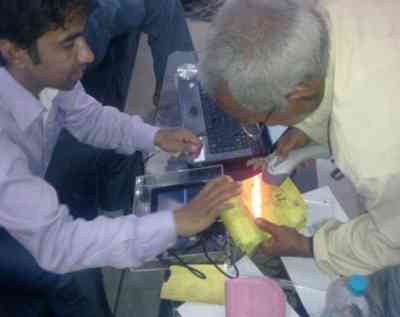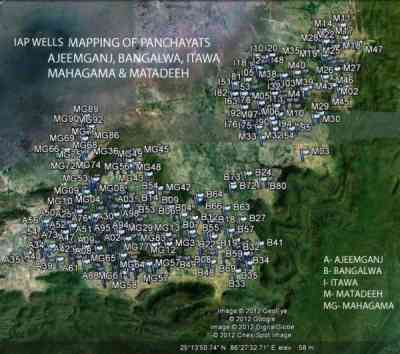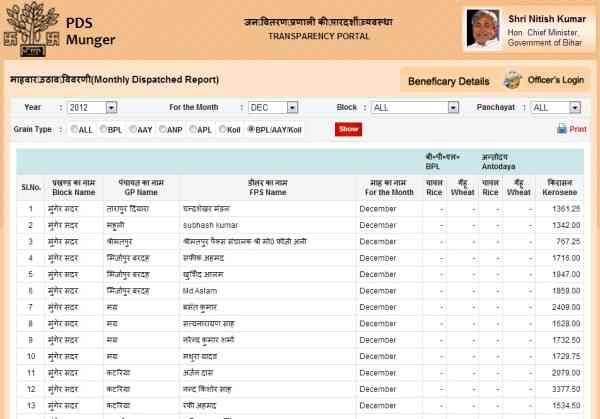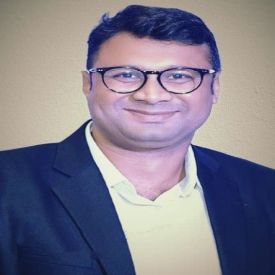How is technology being used to improve public service delivery at the grass root level? In this Note from the Field, the Prime Minister’s Rural Development Fellows that are working with district administrations across the country, share their experiences.
Mr Jairam Ramesh, the Union Minister of Rural Development announced the Prime Minister’s Rural Development Fellows (PMRDF)1 Scheme in September 2011. After a competitive selection process, about 156 talented young professionals were selected to receive PMRDF training. These Fellows have been deployed across 78 backward districts that are a part of the Integrated Action Plan (IAP)2, a special programme of the Government of India.
In this Note from the Field, some of the Fellows tell us about how technology is being used in these districts to facilitate public service delivery. They provide perspectives on how successful these initiatives have been, and the challenges faced, and make suggestions for improvement.
IT based solution for better monitoring of PDS
An IT based solution for PDS called e-PDS has been developed in Gaya, Bihar. The e-PDS aims to ensure that food grains reach the intended beneficiaries and there is no diversion or black marketing of grains. Following are the components of e-PDS:
Integrated Weight Management System (IWMS) - Vehicles carrying food grains are weighed and the weights are automatically transmitted to and stored on remote servers, without any manual intervention. If there is a difference in the weight of food grains on arrival vis-à-vis that of food grains dispatched, an SMS alert is sent to the concerned officials and a theft report is generated.
Management Information System (MIS) - MIS has been introduced to computerise record keeping under the PDS. It contains data on godowns, transporters and trucks, movement of grains, stocks, sale outlets etc. It provides reports relating to daily activity pertaining to the PDS such as orders, sales, financial transactions etc.
Inventory management - The system informs warehouses regarding the quantities of grains that they need to keep in buffer in order to ensure an uninterrupted supply. Inventory reports can be accessed on a portal, with real-time updates.
GPS-based fleet tracking - Trucks transporting grains are fitting with GPS. If a truck transporting grains from the Food Corporation of India (FCI) to the state food corporation godowns diverts from the pre-planned route, SMS alerts are automatically sent to concerned officials. This has also been done in Munger district in Bihar.
Sale to beneficiary - Sales to beneficiaries at outlets are recorded using Point-of-Sale (PoS) terminals. Coupons brought by the beneficiaries are scanned using a barcode scanner, and the information is directly uploaded to the main MIS server where sales reports can be generated.
Citizen interface - Beneficiaries can register on the PDS portal for various SMS alerts. The system automatically generates an SMS to all members of the ward or panchayat level vigilance committee informing them about grain off-take by dealers within the ward.
Figure 1. E-PDS training in Gaya, Bihar
 Kshovan Guha (Gaya, Bihar)
Kshovan Guha (Gaya, Bihar)
Coupon Tracking System to check black marketing in PDS
To address the problem of black marketing of food grains by dealers under the Public Distribution System (PDS) and to ensure that the food grains reach the intended beneficiaries, a Coupon Tracking System (CSM) has been introduced in Jehanabad, Bihar. The CSM tracks the entire cycle of movement of food grains under the PDS. The dispatch of food grains from FCI to the State Food Corporation (SFC), as well the current stock positions of all godowns are recoded into the system. As soon as a PDS dealer collects the food grains from the district administration, an SMS is sent to the entire group of beneficiaries and the data is also posted on a website. Each beneficiary’s coupon is tagged with the individual beneficiary in the system. Once food grains are delivered to the beneficiary, the coupon reaches back to the administration and is scanned, and the delivery is confirmed in the system. This data is also used for generating various reports that are required by the district administration for monitoring the PDS.
While the CSM has greatly enhanced transparency, it has been challenging to design the application given the complexities of the PDS. Integration of the Below Poverty Line (BPL) database with the coupon system has also proven to be difficult. Finally, IT training of the staff involved is required for the successful implementation of the system.
Implementation of RTPS
An ICT (Information and Communication Technology) system has been introduced in Jehanabad district of Bihar as part of the implementation of the Right to Public Service (RTPS) Act 2011. The ICT system has the following components:
Adhikar - This is a service delivery and monitoring software
Online applications - There is a provision for online applications and online delivery of services. On submission of applications, receipts are instantly generated, providing applicants with authentic proof for redressal in case of non-delivery of services requested.
Samadhan - This is an interactive voice response system wherein the citizens can call a helpline and get clarifications regarding their entitlements and services covered under the Act, procedures for filing applications etc.
The use of technology in the implementation of the RTPS has cut down the need to make multiple rounds to government offices, and the scope for bribe demands by officials.
Priyanka Kumari (Jehanabad, Bihar)
Asset Mapping using GPS
In the Purulia district of West Bengal, the PMRD Fellows helped put in place an asset mapping exercise using GPS. This was first done for assets created in the financial year 2011-12 under the IAP. This was followed by mapping by various line departments of the district such as ration shop mapping by the Food and Control department, Primary Health Centres (PHC) mapping by the Health department etc. The aim is to help the district administration with planning.
Figure 2. GPS mapping of IAP wells

Grievance Redressal Cell
A grievance redressal cell called Samadhan has been developed in the Puruli district of West Bengal by the National Informatics Centre (NIC). Under this system, as soon as a citizen registers a complaint, the software automatically generates three SMS’s that are directed to the concerned department, the sub-division office and the block development office/ Gram Panchayat. The complainant is also provided a tentative date of redressal. The concerned department can access complaints on a website and take necessary steps to solve the problem.
Though this mechanism, the district officials have addressed a number of problems in public service delivery. It has helped develop a relationship between the administration and the citizens, and has provided a platform for citizens to share vital information with the administration easily, and without delay or distortion.
Animesh Ghosh (Purulia district, West Bengal)
MoIS for MNREGA
MNREGA requires intense monitoring because of its massive scale and decentralised character. In the absence of required human resources, the district administration of Munger in Bihar introduced Mobile Inspection System (MoIS). MoIS installed android phones were provided to programme officers, which the help of which photographs taken at the time of inspection could directly reach the district authorities. This enabled the administration to centrally monitor and inspect MNREGA work and asset quality.
Figure 3. Picture from MNREGA field inspection report, Munger district, Bihar

Use of GPS for e-PDS and asset mapping
The Munger administration has installed GPS devices on vehicles involved in transporting food grains under the PDS. Detailed information on PDS is maintained. SMS’s are sent to the entire group of beneficiaries as soon as a dealer collects grains from the administration. This enables curbing any possible diversion as well as ensures better monitoring of the entire PDS system.
Figure 4. E-PDS website, Munger, Bihar

Figure 5. GPS mapping of trucks carrying food grains under PDS at Munger, Bihar

Through GPS, a mapping of over 400 irrigation wells sanctioned under the IAP was done. This helped the administration with planning as they could ensure better coverage and also identify areas to be covered in the next phase. With the help of GPS mapping of roads, the administration is identifying and bridging connectivity gaps.
Ankush Singh (Munger district, Bihar)
National e-Governance Plan
Funded under the Integrated Action Plan (IAP)3, the National e-Governance Plan aims to provide support to the district administration to facilitate development of G2C (Government to Citizen) services. The three pillars of the infrastructure used to implement the plan are the state data centres, state-wide area networks and common service centres (CSC).
Jharkhand has been selected as the pilot state for the implementation of this Plan, and Ranchi is the pilot district within Jharkhand. So far, it has been launched successfully in at least one panchayat of all 18 blocks of the district. Five online services namely, birth certificates, death certificates, income certificates, local residential certificates and caste certificates, have been made available at CSCs at a nominal processing fee of Rs. 154. This has greatly benefited the citizens who earlier had to spend a lot of money and time in obtaining these documents from block offices and district headquarters. Other services such as revenue courts, electoral services, consumer court services etc. can be accessed via external links that have been provided on the home page of the website5. There are plans to introduce other services such as pensions (old age, widow and handicap), RTI (Right to Information) and Grievance Redressal, and government dues and recoveries in a phased manner.
For successful implementation of this project, good connectivity at the panchayat/ CSC and the block level needs to be ensured. Also, digital signatures of all concerned government officials should be formally issued, and proper training should be given to the staff involved.
It is hoped that this project will simplify processes and hence, reduce the administrative burden of the district administration. It will also enhance transparency and accountability in service delivery, and make the district administration more citizen-friendly in general.
Dipti Paridhi Kindo (Ranchi, Jharkhand)
Malnourished children identification software
I observed that the calculation of the number of malnourished children in Mandla district of Madhya Pradesh is not very accurate as this is done manually by anganwadi workers who are not properly trained. I brought this problem to the attention of the district administration, and introduced an online software to address it (http://vatsalyamandla.org). Records of weight to age ratios are maintained for all children at the anganwadi level. The software creates graphs indicating the children that are malnourished, as per WHO guidelines. Alerts are sent to key officials regarding malnourished children identified by the system to ensure follow-up. Such a system can ensure accurate monitoring of malnourished children.
Telemedicine centre for the tribal
The rural, tribal people of the district of Mandla in Madhya Pradesh do not have access to quality healthcare services. There is a shortage of medical staff as well as advance medical equipment at rural health centres.
Under the IAP, funds have been sanctioned for a Telemedicine centre in Mawai – the remotest block of the district. It is envisaged that this centre will be connected with the district hospital and medical colleges, and will enable rural tribal people to seek expert advice at rural health centers via video telephones. These centres can also be used for counselling of pregnant women and adolescent girls, and training of ASHA, ANM , MPW and other field workers. These centre can also play a vital role in screening of Rajya Bimari Sahayata Nidhi and Bal Hridaya Upchar Yojana and Atal Bal Arogya Mission patients.and making people aware of various health programmes , schemes, new protocols , new drugs, immunisation and prevention from epidemic like swine flu etc.
The district collector, chief medical officer and other district officers have been given a demonstration of the telemedicine initiative.

Sushma Taywade (Mandla district, Madhya Pradesh)
Biometric system to ensure attendance
The Kendujhar district in Odisha was facing a problem of staff absenteeism in public service delivery. It was observed that mobile units did not visit certain villages, nursing staff were not present at Village Health and Nutrition Day (VHND), residential school staff showed fake attendance, and the AWC (Anganwadi Centre) staff was mostly absent.
In order to address this problem, a biometric attendance system has been put in place by the district administration. This has been funded via the PPP model. Solar energy is used to recharge the equipment in places where electricity is not available.
It is envisaged that such a system will result in enhanced employee accountability and increase transparency. Since the introduction of biometric attendance, attendance levels of medical staff at various hospitals as well as of staff at AWC centres have gone up. It has also made it easier to track movement of field officers.
However, a huge number of enrolments need to be done which has proven to be a herculean task. Integration and analysis of data as well as producing attendance reports are additional tasks that existing staff need to perform. Help of civil society organisations located in the villages is sought to overcome these challenges and ensure that the system is successful is achieving its goals. Also, it should be noted that a biometric attendance system can only ensure presence and not the effort put in by the staff and hence, quality of public service delivery.
Chandrasekhar Prasad (Bans-pal block, kendujhar district, Odisha)
MIS data for MNREGA
While conducting social audits for MNREGA, the PMRD Fellows in the Kothar panchayat in Odisha, my colleague Vaibhav Maheswari and I realised that there was a great deal of mistrust among MGNREGA workers with respect to documents of Rozgar Sevaks6. Various questions were raised regarding underpayment.
The PMRD Fellows won the trust of the workers by showing them real time Management Information System (MIS) data for MNREGA. They felt that this had an impact and the turn-out of workers at block and district public hearings increased
Sweta Trayambak (Kothar Panchayat, Odisha)
Notes:
- http://pmrdfs.tiss.edu/
- For more information, please see http://pcserver.nic.in/iapmis/ or http://pib.nic.in/newsite/erelease.aspxrelid=79472
- For more information on the IAP, please see http://pcserver.nic.in/iapmis/
- Applications are submitted online at CSCs and certificates are made available at the CSCs. CSCs are located at panchayat bhawans and other local sites
- www.jharkhand.gov.in/e-district
- Rozgar Sevaks are support staff appointed in every panchayat to assist with the implementation of MNREGA.




 06 February, 2013
06 February, 2013 











Comments will be held for moderation. Your contact information will not be made public.